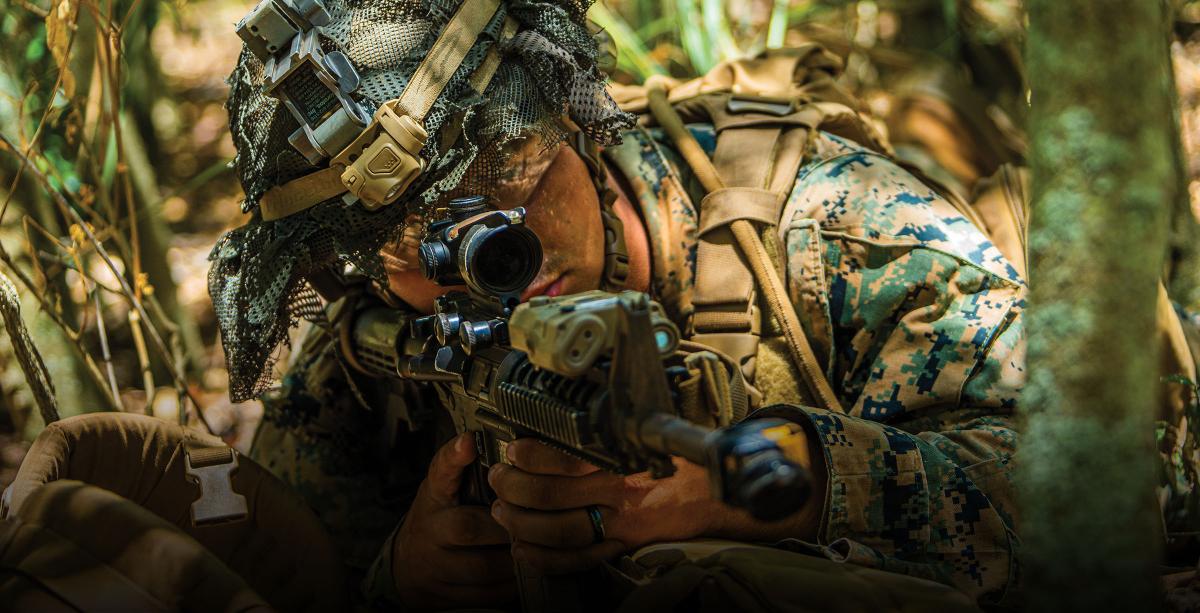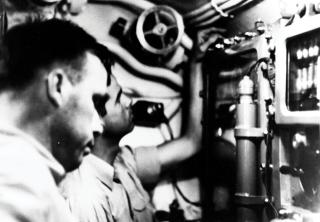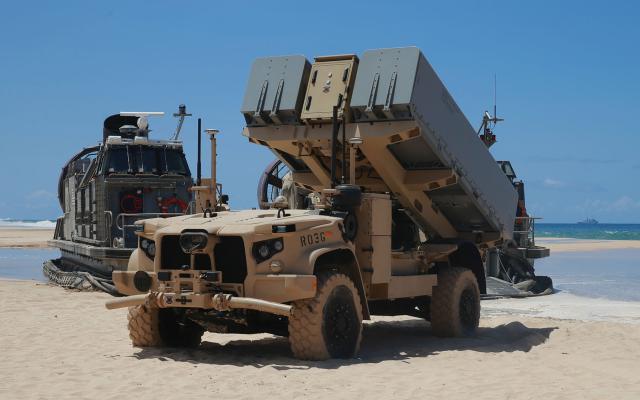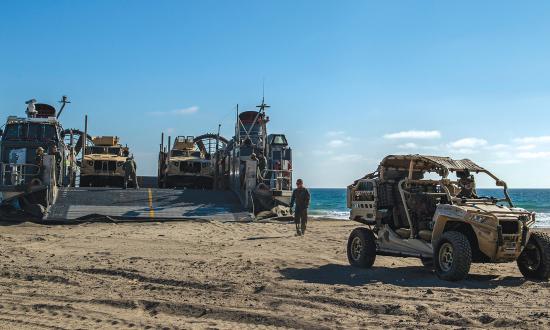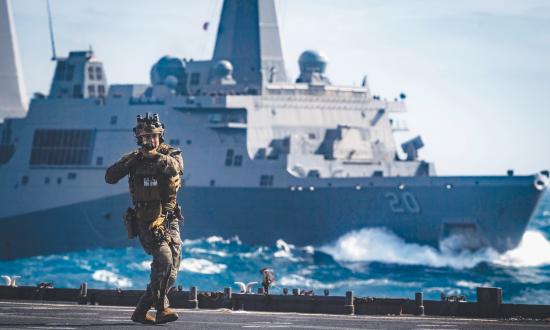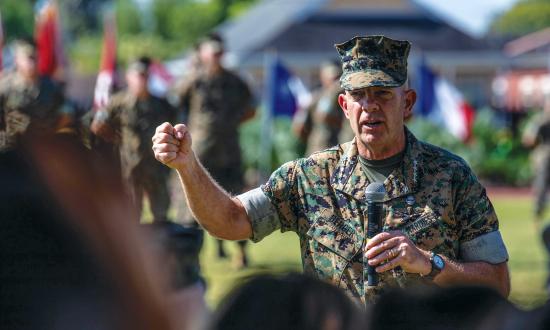Mental models are how humans make sense of a complex world. We build simplified pictures that aid our decision-making and interpretation of events and shape our worldview.1 However, the mental models theory also identifies a key limitation in the way humans make sense of the world: If something does not fit the preexisting model, it often is ignored or misinterpreted. If there are changes in the context of an existing model, it may no longer provide a useful starting point for understanding events, and the gaps might confuse rather than help shape understanding.
As the Marine Corps enters a time of both geopolitical and internal change, it must reflect on and update its existing mental models to correspond to the requirements of today’s world.
The Sea Denial Mission
In his 2019 planning guidance, Commandant of the Marine Corps General David Berger stated he intends to reconfigure the force to conduct sea denial operations in support of a naval campaign.2 This effort has begun: Experimentation with the Marine Littoral Regiment is occurring, and divestment of legacy capabilities is underway. As the Corps continues to develop the sea denial mission, it will require new mental models to support it. Indeed, the force will need education to support new thinking about the multitude of possible operations the Marine Corps might conduct to support fleet action.
Currently, the service’s thinking, education system, and training pipelines are fundamentally based on land operations. It studies and venerates ground theorists and warfare far more than its naval counterparts, and it has experience fighting as a second land army for roughly the past 20 years. Even when Marine forces embarked on board Navy ships in the past two decades, the agreement often was that the Navy managed the fight at sea, while the Marine Corps took over once forces transitioned ashore.3 Although not automatically wrong, this thinking provides Marines only a single baseline mental model—land warfare.
As the Corps creates a force capable of sea denial operations in a broad variety of geographies, it needs examples that can help leaders develop mental models beyond the existing paradigm of land warfare.
Modern naval thinkers usually consider sea denial an inherently defensive mission, but it bears only a tangential resemblance to the sort of ground defense many Marines think of when they consider how the force might execute these operations.4 There are crucial differences between sea denial in support of the fleet and the infantry- or armor-based models for tactical defensive operations that come to most Marines’ minds when they think of “denying” something to an enemy.
The closest analog for sea denial in Marine Corps Doctrinal Publication (MCDP) 1-0, Marine Corps Operations, is probably area defense. According to MCDP 1-0, area defense “denies the enemy critical terrain or facilities for a specified time. . . . [it] focuses on the retention of terrain by absorbing the enemy into a series of interlocked positions from which, through friendly maneuver and fires, he can be destroyed.”5
Alternately, mobile defense might be a better fit, although for sea denial operations it would require significant naval maneuver forces that likely will remain beyond the capability of Marine units. MCDP 1-0 indicates mobile defense requires mobility and striking power—for sea denial against a peer navy, this suggests a large number of warships.6
A third broad concept that some Marines have discussed is employing a “stand-in force” to seize and hold a location within the enemy’s weapons engagement zone (WEZ) from which to conduct sea denial operations. Some have characterized Operation Watchtower on Guadalcanal as the best example of this type of operation.7 In many ways, however, it might more resemble the “deep operations” of the Chindit long-range penetration units and Merrell’s Marauders in World War II.8
Although each of these conceptual models has some application and relevance, the reality is that when most Marines think of defensive operations, they picture their experience actually executing the defense. For most, this means field exercises at entry-level training. Indeed, nearly every Marine in the force today had some experience at service schools establishing a tactical defense (“digging in”). More-experienced Marines also will recall establishing defenses at Twentynine Palms as part of the variety of exercises conducted there during the past half-century and perhaps even during actual ground combat operations.
There are multiple issues with using these experiences as a baseline mental model for sea denial operations: They are inherently short range (compared to modern naval combat), and they take place in the sterile, controlled environment of a military training area. There are no civilians, no fights for sortie allocations, no targeting boards prioritizing assets away from the generally unimportant (risk-worthy) stand-in force, and no composite warfare commander in ultimate control. The idea many Marines have in their heads of a defense with range rings, obstacles, and engagement areas is not one that grapples with many of the problems that would arise in attempting to employ sea denial forces in accordance with the service’s existing models for defensive operations.
As the Corps begins to consider what sea denial truly means, the best option is to move away from the land warfare paradigm and develop a different mental model—one based on a campaign most Marines probably have not considered: World War II submarine operations.
Submarine Ops In the Pacific Campaign
Submarine operations appear to have little in common with Marine Corps operations, whether in support of the fleet or not. In this case, however, appearances deceive. Submarine operations, and the World War II Pacific campaign more specifically, provide a useful concept on which to model emerging concepts for sea denial for several reasons.
First, at the level of broad conceptual strategy, the application of what J. C. Wylie termed a “cumulative strategy” is likely to be the most effective way of employing dispersed Marine sea denial forces. The Pacific submarine campaign was a cumulative strategy: Submarine warfare was additive over time and focused on total effect, not sequential, discrete steps to an objective. This is a useful way to think of future Marine Corps operations. Unlike the Marine experience in World War II—the well-known “island hopping campaign”—modern Marines fighting in the Pacific (or littorals around the globe) should not necessarily try to achieve a series of specific objectives (Wylie’s “sequential strategy”), but instead should be tasked to engage and eliminate broad categories of enemy forces when and how they are able.9 Depending on target prioritization and combined with air power and fleet activities, this sort of cumulative action could be used in a variety of ways to achieve effects from tactical to strategic. To wit: The Pacific submarine campaign in World War II supported strategic economic strangulation of Japan, operational isolation of battlespace, and specific tactical fleet actions at multiple points throughout the war.10
Second, specific tactical methodology is worth discussing as well. The idea of a stand-in force has led some to advocate for Guadalcanal as a model for sea denial. Guadalcanal, although useful for describing power projection from an isolated location, is less applicable today with the proliferation of massed precision fires. Indeed, the “maritime fortress” model of a stand-in force is risky given peer competitors’ targeting and destructive capabilities—although some thinkers suggest that modern capabilities might enable fortresses to survive and even thrive in a sea denial fight.11
Nonetheless, instead of picturing Marine stand-in forces as modern-day Guadalcanals, the Corps should imagine them operating as submarines: self-contained firepower moving at will within the enemy WEZ. The basic submarine warfare approach for much of the Pacific war included some simple guiding principles:
1. Operate alone (early war) or in a small group (late war, around three submarines).12
2. Before leaving port, agree with higher headquarters on the desired end state.
3. Don’t be found unless you unmask on purpose.
4. When you identify targets worth sinking and that meet target prioritization, engage them.
5. Continue executing #3 and #4 until you run out of ammunition or fuel.
Famous examples of this sort of employment include Lieutenant Commander Dudley “Mush” Morton’s operations in 1943–44 and the exploits of Lieutenant Commander Dick O’Kane, among many less famous examples.13
Combining this model with some of the more specific ideas that Marines have advanced since publication of the Commandant’s Planning Guidance would be a winning combination.14 Instead of building a “defense” in the littorals, the model instead would create offensively minded maneuver units. Following similar principles as the World War II submariners, these units would stay hidden while moving to positions where they could unmask, engage, and transition back into concealed movement. They would need to be able to maintain radio silence, deliberately manage information and electromagnetic signature, maneuver at will throughout the battlespace (whether ashore or afloat), detect enemy shipping or receive targeting information from adjacent units, and engage without asking for permission.
Similar to World War II submarines, they also would need to be “risk-worthy.” Just as the Pacific Fleet understood in World War II that the loss of a submarine was not a war-changing event, the loss of elements of a Marine littoral regiment must also be an acceptable price in peer conflict. Ultimately, these units would remain hidden and thus generally protected; be able to identify and engage targets based on their own understanding of rules of engagement, target identification, and their organic capabilities; and engage enemy forces in accordance with previously directed target precedence, engagement criteria, or other orders until told otherwise, out of ammunition, or requiring some other resupply.
This sort of independent, dispersed, cumulative action could mitigate many of the most difficult issues that might affect Marine units’ capability to interface with Navy forces and directly enable a naval campaign.15 The submarine force in the Pacific war remained fiercely independent from the rest of the fleet and usually did not directly support tactical fleet actions. It nonetheless had a massive impact on the war through its steadily accruing sea denial campaign. Marine Corps stand-in forces could create a similar cumulative effect and, when necessary, also directly support fleet action—just like the submarine force in World War II.
When submarines were employed in support of tactical fleet actions, they aided in operational isolation, deep interdiction, and tasks to enable the fleet in specific missions (engaging the enemy battle fleet, executing amphibious assault, etc).16 One could envision this in a modern scenario where the fleet is fighting “outside-in”: Marine Corps stand-in forces interdict the enemy fleet and isolate the main battle area, facilitating friendly fleet freedom of maneuver and local sea control. Instead of trying to create defensive “surfaces” for the enemy fleet to smash into, these Marine “hunter-killer teams” would move within contested battlespace and sink specific enemy targets whenever identified.
Sea denial encompasses a huge range of possible missions. Indeed, the broad expeditionary advanced base concept has any number of possible elements to it, from expeditionary F-35 forward arming and refueling points, to support bases for submarine-hunting aircraft, to early-warning sites that will provide increased maritime domain awareness. Deep within the WEZ, however, is where the sea denial fight will be most intense. The idea of creating a defense with interlocking fires, obstacle plans, and defined engagement areas is one that intuitively appeals to most Marines. Like any familiar mental model, they put it on like a well-worn pair of boots. It is comforting and simple to imagine a familiar scenario with some slight tweaks: instead of brown desert, blue ocean; instead of armor and infantry, enemy ships; instead of cannon artillery, antiship cruise missiles. Although this is an intuitively simple idea that transposes easily, to use the model of land warfare as the Marine Corps’ primary way of thinking about sea denial would be a mistake. The idea of risk-worthy units, hiding from the enemy until they decide to engage, remaining silent and operating off of commander’s intent to achieve a cumulative effect, is one that offers much opportunity. A key model to use for educating the force is one Marines almost never think about: the Silent Service of World War II.
1. Peter M. Senge, The Fifth Discipline: The Art & Practice of the Learning Organization (New York: Doubleday, 1990), 174–78.
2. Gen David H. Berger, USMC, Commandant’s Planning Guidance (Washington, DC: Headquarters Marine Corps, 2019), 23.
3. The author has heard this stated in conversation between U.S. Navy and Marine Corps senior leaders.
4. For discussion of sea denial as strategy, see Sam J. Tangredi, Anti Access Warfare: Countering A2AD Strategies (Annapolis, MD: Naval Institute Press, 2013), 36–38. Also see Milan Vego, Maritime Strategy and Sea Denial: Theory and Practice (New York: Routledge, 2019), 104–20.
5. Marine Corps Doctrinal Publication 1-0 (MCDP 1-0), Marine Corps Operations (Washington, DC: Headquarters Marine Corps, 2019), 8-7.
6. MCDP 1-0, Marine Corps Operations, 8-5–8-6.
7. Staff, Marine Corps University, “How to Fight and Win the Single Naval Battle: Operation Watchtower’s Relevance Today,” Marine Corps Gazette, April 2018, 86–87.
8. Center of Military History, Merrill’s Marauders: February–May 1944, 50th Anniversary Edition (Washington, DC: U.S. Army, 1990).
9. J. C. Wylie, Military Strategy: A General Theory of Power Control (Annapolis, MD: Naval Institute Press, 1967), 24–25.
10. Strategic and operational, see Craig Symonds, World War II at Sea: A Global History (New York: Oxford University Press, 2018), 589–97. Tactical/special missions, see Charles A. Lockwood, Sink ’em All (New York: Bantam, 1951), 355–56.
11. Shang-su Wu, “The Modern Naval Fortress: An Additional Sea Denial Option for Coastal States,” Defence Studies 18, no. 1 (March 2018): 76–94.
12. Symonds, World War II at Sea, 590–92.
13. Clay Blair Jr., Silent Victory: The U.S. Submarine War against Japan (Annapolis, MD: Naval Institute Press, 1975).
14. Jake Yeager, “Expeditionary Advanced Maritime Operations: How the Marine Corps Can Avoid Becoming a Second Land Army in the Pacific,” War on the Rocks, December 2019.
15. For examples of some of the outstanding issues with Marine Corps force design efforts, see Gen David H. Berger, USMC, Force Design 2030 (Washington, DC: Headquarters Marine Corps, March 2020).
16. For examples, see Ian W. Toll, Twilight of the Gods: War in the Western Pacific, 1944–1945 (New York: W. W. Norton & Company, 2020); also Samuel Eliot Morison, The Two Ocean War: A Short History of the United States Navy in the Second World War (Boston: Little, Brown and Company, 1963).



